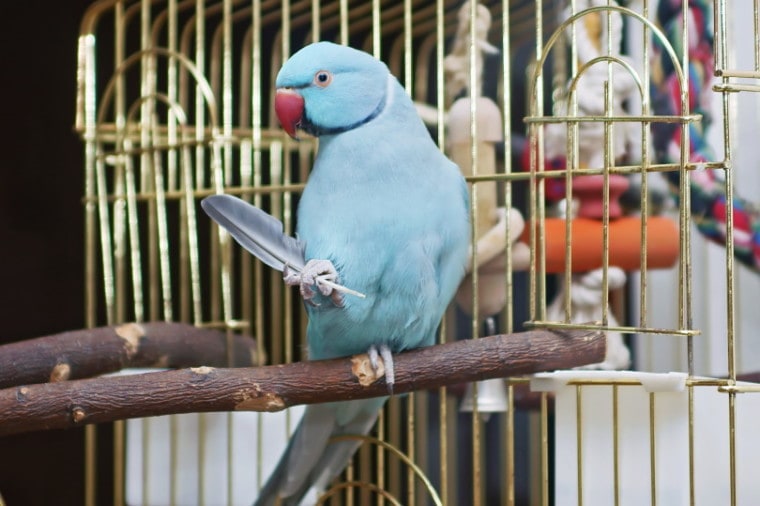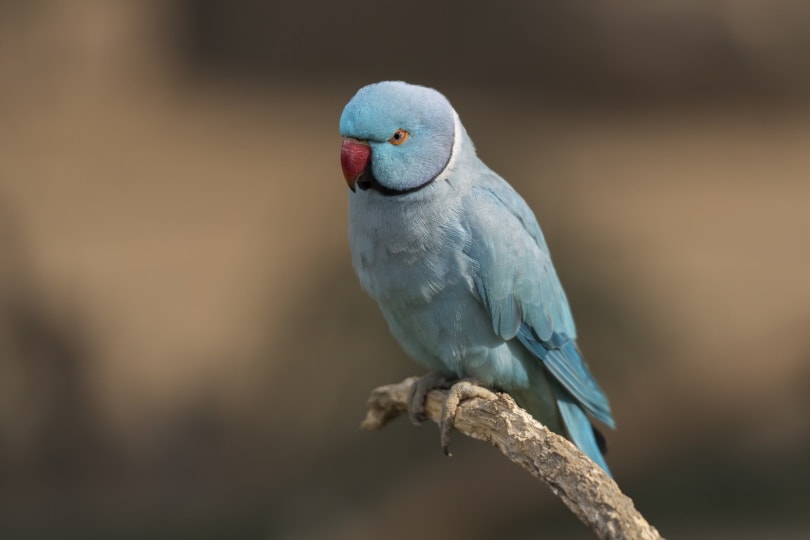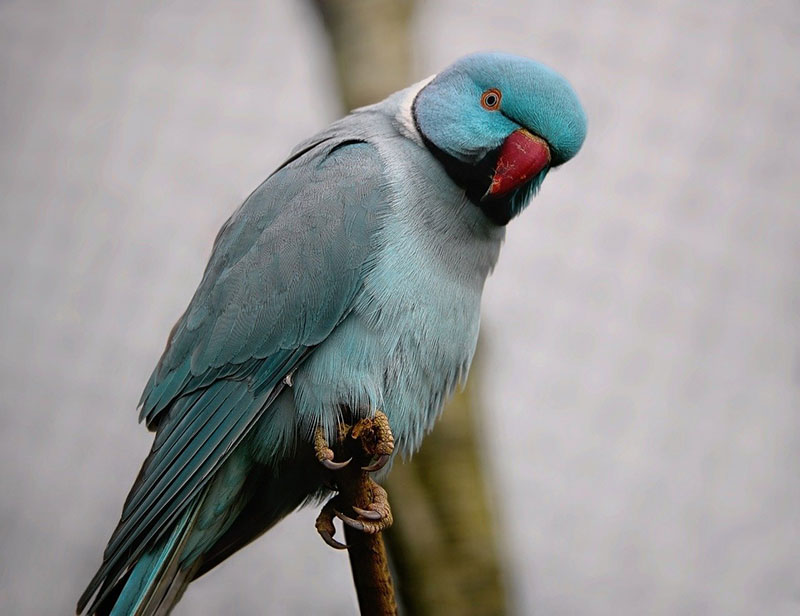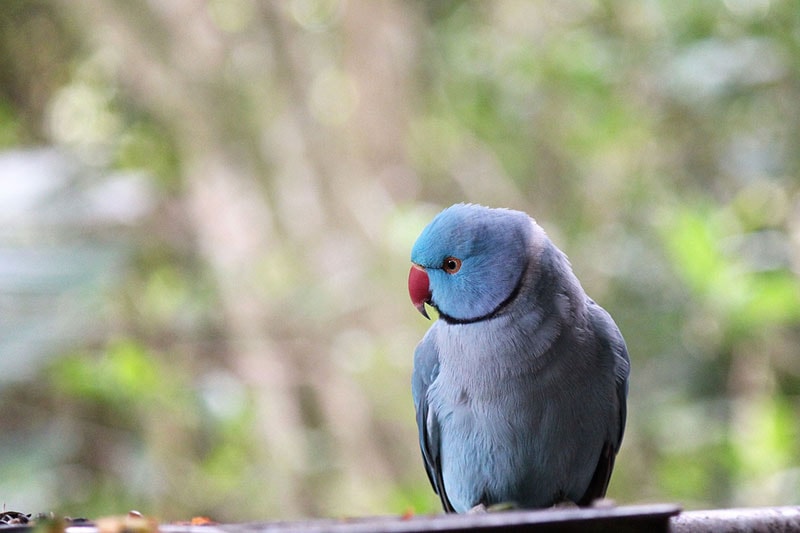
The blue Indian ringneck is a stunning medium-sized parakeet with a vivid light blue coloration. They are very energetic, intelligent, and talkative pet birds. In the wild, they are found in parts of Asia and became popular birds in the pet trade in the early 1900s. The blue Indian ringneck is the blue color variation of the Indian ringneck parakeet that comes in a variety of different color mutations.
Species Overview
| Common Names | Blue Indian Ringneck Parakeet, Blue Indian Ringneck Parrot |
| Scientific Name | Psittacula krameri |
| Adult Size | 14–17 inches, 4–5 ounces |
| Life Expectancy | 30+ years |
Origin and History

The blue Indian ringneck parakeet is a color variation of a subspecies of the rose-ringed parakeet. They are an Asiatic parakeet that originates in Ceylon but can now be found throughout Asia, predominantly in India and Pakistan.
The blue Indian ringneck parakeet will be found in lightly wooded areas in the wild. They are social birds that typically travel in flocks of 100 or more. Indian ringneck parakeets as a whole have been kept as pets as early as 200 B.C. When it was discovered that they were able to mimic human speech, they became regarded as sacred in India.
The wealthy people of India were known to keep their sacred pets in very decorative cages to be admired by guests for their stunning coloration, lively personality, and ability to mimic humans.
Indian ringneck parakeets became popular in the pet trade in the 1920s when breeders began producing different color mutations, such as the blue Indian ringneck. They are now widely available in the pet trade and are extremely popular among bird lovers.
Temperament

The blue Indian ringneck can be a very charismatic and charming pet bird. Their intelligence makes it easy to train them to perform a variety of tricks and to speak a decent number of words.
They do have a reputation for being nippy, temperamental, and a bit stubborn. This is usually resulting from a lack of proper training, socialization, and overall attention. This species is extremely intelligent, and they do bore very easily. A potential owner needs to understand their needs before bringing them home as a pet. When they become bored and feel neglected, they typically begin unwanted behaviors such as chewing and biting.
It is very common for adolescent Indian ringnecks to go through what is called a “bluffing” stage that can be difficult to manage. During this time, they will be slightly aggressive but it typically only lasts a few weeks to a couple of months.
When blue ringnecks are well cared for and given the handling and attention they need, they have very sweet, charming personalities. Don’t be discouraged if your bird seems a bit aloof, it’s just how this species is. They do not tend to be affectionate with their owners.
It’s been noted that females will bond better with their human companions, but males are typically more docile than females. They do enjoy rides on the shoulder, and it’s recommended you introduce them to friends and family to help them socialize well.
Blue Indian ringnecks can be aggressive and territorial toward other birds, for this reason, they should always have their own sleeping cage. They can get along very well with others of the same species if given enough space.
Speech & Vocalizations

The blue Indian ringneck is a very vocal and talkative bird. They generally begin mimicking human speech somewhere between 8 months to 1 year of age. They are very intelligent and can learn to mimic over 200 words. You’ll be impressed by how quickly they can learn.
These birds are particularly chatty once they learn to speak. You’ll want to be careful what you teach them to say because you will be hearing it repeatedly. In addition to speech, blue Indian ringnecks will often whistle and produce very high-pitched tones. If they become angry or afraid, you will know, as they will let out a high-pitched scream.
Blue Indian Ringneck Colors and Markings
Their striking coloration is one of the many reasons the blue Indian ringneck is such a popular pet bird. Their bodies are a stunning light blue color, and all feathers are of the same coloration. They have vibrant red beaks that stand out against their feathers. Males have a black stripe around their neck that resembles a collar.
Caring for the Indian Blue Ringneck

A blue Indian ringneck will need a larger cage than what you may expect. These active birds need a lot of space to move around freely and get their exercise. You need to make sure the bar spacing is adequate so they cannot escape or get stuck in between them. Typically, you’ll want bar spacing from ½–⅝ inches for this sized bird.
You will want to fill your bird’s cage with various perches, ladders, chewable toys, and puzzles. They are very intelligent and require a great deal of mental stimulation. You will want to rotate the items available to them so these curious little birds can avoid boredom. It’s highly recommended you dedicate a space in your home outside of the cage for your bird to get exercise.
If you notice any aggressive behaviors, it’s best to pay them no mind and use positive reinforcement for training. They will thrive on learning new tricks and words. They will require a lot of your time and attention, so you need to ensure you have enough spare time to dedicate to your blue Indian ringneck.
You will need to clean the food and water bowl daily, perches and toys weekly, and the floor of the cage at least monthly. Feeding them a proper diet and providing clean, fresh water for drinking and bathing is essential. It’s always recommended to have an avian veterinarian close by to discuss and care for health-related questions you may have for your bird.
Common Health Problems
Blue Indian ringneck parakeets are typically very healthy pet birds as long as they are receiving proper care, a well-balanced diet, and plenty of attention. They are however prone to some diseases and bacterial infections.

Diet and Nutrition
In the wild, Indian ringnecks survive on a diet of fruits, vegetables, nuts, berries, a variety of seeds, and flower nectar. Your pet bird needs to get a well-balanced diet in captivity to ensure its overall health and longevity.
The diet you feed your blue Indian ringneck parakeet is very important. A high-quality dry food mix that includes pellets, seeds, grains, and nuts is ideal. They will also enjoy a variety of fresh fruits, dark leafy greens, and vegetables.
Fruits are a great source of antioxidants for your bird. Apples and grapes are among their favorite fruits to eat but you’ll want to offer them a variety. Some other fruits to add to their diet include oranges, kiwis, pears, mangos, and melons. Never feed them old or rotten fruits.
Leafy greens and vegetables such as chard, kale, carrots, corn, celery, and squash are all great choices to include in their fresh diet. Offering a protein source such as shredded turkey or chicken once every week or so is acceptable.
Clean, fresh water for drinking and bathing should be always available to your bird.
Exercise
As with most bird species, the blue Indian ringneck parakeet is a very active bird that will require a lot of exercise and stimulation. It is highly recommended that you have a designated safe area for them to stretch their wings and play outside of the cage for at least an hour or more each day.
Providing them a variety of chewable toys, perches, and cage accessories will help stimulate them and prevent them from becoming destructive or getting into something they shouldn’t. They are very intelligent and will enjoy puzzles and complex toys.
These birds like to keep active and do not enjoy sitting still for very long. It’s important to keep up with their needed physical activity to keep them from becoming stressed. When they do not get enough stimulation, they can become aggressive or even begin plucking their feathers.

Where to Adopt or Buy a Blue Indian Ringneck
Blue Indian ringnecks are common in the United States and can either be purchased from a reputable breeder or organization or adopted from a bird rescue. The price of this bird is generally around $400 to $700, though they can be found in the price range of $250 to $1,200 depending on where you purchase your bird and the vetting that has been completed.
If you choose to purchase directly from a breeder, you will want to check and make sure they are a reputable breeder with experience with the Indian ringneck species. If you choose a rescue, they do a great job of matching their birds with the best owners to ensure compatibility. These birds will come with all information the rescue has on them and are typically fully vetted before adoption.
Regardless, you’ll want to make sure you are bringing home a healthy bird. You’ll want to ensure they have all their feathers and are active and alert.
Summary
Though they are not ideal for novice bird owners, with proper handling, care, and attention, the blue Indian ringneck parakeet can become a beloved, lifelong pet. They will enjoy learning new things, challenging their smarts, and mimicking their owners.
It’s important to understand all the dietary, care, and overall needs of a specific species of a pet bird to ensure it will make the right pet for you. Hopefully, you’ve learned a lot about the blue Indian ringneck, and you can make the best decision for yourself!
Featured Image Credit: Eudyptula, Shutterstock








